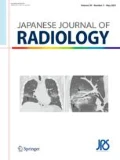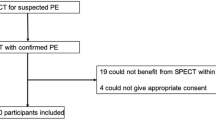Abstract
Purpose
To determine the utility of dual-energy perfusion CT (DEpCT) of non-diseased lung segments, using dual-source CT, in comparison with perfusion single-photon emission computed tomography (SPECT).
Materials and methods
28 patients (18 male and 10 female; mean age 63 years; age range 18–86 years) underwent DEpCT and SPECT within a 3-day interval. The presence and location of perfusion defects in each segment of the lungs were evaluated.
Results
Perfusion defects were noted in 7 of 361 segments (1.9 %) by DEpCT and in 19 of 361 segments (5.3 %) by perfusion SPECT. DEpCT was in good agreement with perfusion SPECT for 338 of 361 segments (93.6 %). Intraobserver agreement was also good, ranging from 93.4 to 93.6 % (κ = 0.64–0.75, p < 0.01).
Conclusion
For non-diseased lung segments, DEpCT correlated well with SPECT.




Similar content being viewed by others
References
Hatabu H, Tadamura E, Levin DL, Chen Q, Li W, Kim D, et al. Quantitative assessment of pulmonary perfusion with dynamic contrast-enhanced MRI. Magn Reson Med. 1999;42:1033–8.
Prologo JD, Gilkeson RC, Diaz M, Asaad J. CT pulmonary angiography: a comparative analysis of the utilization patterns in emergency department and hospitalized patients between 1998 and 2003. AJR. 2004;183:1093–6.
Bajc M, Albrechtsson U, Olsson CG, Olsson B, Jonson B. Comparison of ventilation/perfusion scintigraphy and helical CT for diagnosis of pulmonary embolism; strategy using clinical data and ancillary findings. Clin Physiol Funct Imaging. 2002;22:392–7.
The PIOPED investigators. Value of ventilation/perfusion scan in acute pulmonary embolism: results of prospective investigation of pulmonary embolism diagnosis (PIOPED). J Am Med Assoc. 1990;263:2753–9.
Kluge A, Rominger M, Shönburg M, Bachmann G. Indirect MR venography: contrast media protocols, post processing and combination with MRI diagnostics for pulmonary embolism. Rofo. 2004;176:976–84.
Thieme SF, Becker CR, Hacker M, Nikolaou K, Reiser MF, Johnson TR. Dual energy CT for the assessment of lung perfusion–correlation to scintigraphy. Eur J of Radiol. 2008;68:369–74.
Okada M, Kunihiro Y, Nakashima Y, Matsunaga N, Sano Y, Yuasa Y, et al. The low attenuation area on dual-energy perfusion CT: correlation with the pulmonary function tests and quantitative CT measurements. Eur J Radiol. 2012;81(10):2892–9.
Marks LB, Munley MT, Spencer DP, Sherouse GW, Bentel GC, Hoppenworth J, et al. Quantification of radiation-induced regional lung injury with perfusion imaging. Int J Radiat Oncol Biol Phys. 1997;38:399–409.
Suga K, Iwanaga H, Tokuda O, Okada M, Tanaka N, Matsunaga N. Steal phenomenon-induced lung perfusion defects in pulmonary arteriovenous fistulas: assessment with automated perfusion SPECT-CT fusion images. Nucl Med Commun. 2010;31:821–9.
McDonald DM. Angiogenesis and remodeling of airway vasculature in chronic inflammation. Am J Respir Crit Care Med. 2001;164:39–45.
McDonald DM, Baluk P. Imaging of angiogenesis in inflamed airways and tumors: newly formed blood vessels are not alike and may be wildly abnormal. Chest. 2005;128:602–8.
James AL, Wenzel S. Clinical relevance of airway remodeling in airway diseases. Eur Respir J. 2007;30:134–55.
Schenzle JC, Sommer WH, Neumaier K, Michalski G, Lechel U, Nikolaou K, et al. Dual energy CT of the chest: how about the dose? Invest Radiol. 2010;45(6):347–53.
Kang MJ, Park CM, Lee CH, Goo JM, Lee HJ. Focal iodine defects on color-coded iodine perfusion maps of dual-energy pulmonary CT angiography images: a potential diagnostic pitfall. AJR. 2010;195:W325–30.
Author information
Authors and Affiliations
Corresponding author
About this article
Cite this article
Kunihiro, Y., Okada, M., Matsunaga, N. et al. Dual-energy perfusion CT of non-diseased lung segments using dual-source CT: correlation with perfusion SPECT. Jpn J Radiol 31, 99–104 (2013). https://doi.org/10.1007/s11604-012-0153-9
Received:
Accepted:
Published:
Issue Date:
DOI: https://doi.org/10.1007/s11604-012-0153-9




